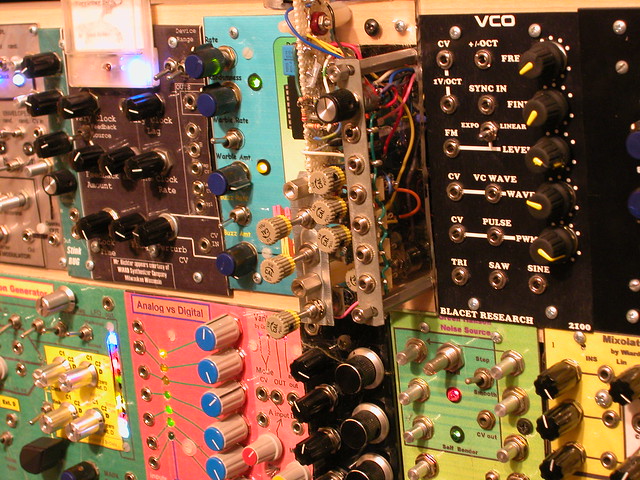Modules & Modulars
Two questions…
Why does this documentation exist?
Many of the block diagrams in this section were originally presented privately to Grant Richter in order to clarify ideas that I was discussing with him. He later, indulgently published them on a sub-page of his wonderful musicsynthesizer.com site. When I first saw my hackneyed schemes on a web page, I confess to a bit of embarrassment. Grant professes that my concoctions are meritorious in their way. He’s a ‘big-tent’ theorist.
Nevertheless, I would be plain foolish to demur from the de facto encouragement of Grant’s efforts on my behalf and I’m too fat and homely to play the coquette convincingly anyway. Grant later asked that I augment the pictures with commentary text and it would have been ungracious to decline.
But I offer one honest disclaimer: The block diagrams, like all my documentation, were drawn as insurance against my own creeping senility and designed for an audience of one; myself. They were intended as components of repair manuals for myself and not really as expositions of my design naivete’. – I’m not sure that my smartass commentary will SUBTRACT from the confusion! But we’ll see…
Do your designs ‘work’?
No… they play.
At my day job – I make my living as designer of ‘wares’ (soft to firm to hard) for business applications. In terms of design, this realm rewards- cowardice (unless you count the courage it takes to brazenly pilfer a competitors design) conventionality (you don’t want to disorient your customers.. or your marketing dept.) and economy (when it breaks they’ll have to buy another one) My designs for Modern Implement are a deliberate tonic for this pallid ethic.
They are not designed for ‘production’ in any way. I will purposely devise circuitous, rococo Rube Goldberg-style kluges just to see what they do and use them (and their quirks) just because I already built them. It is a design-ANTI-philosophy constructed of caprice and Ars Gratia Artis. If I apply one rule, it is simply that the module do something that amuses me.
I normally work ‘in-vivo’, on a proto-board with the output of the circuit connected, at all times, to a bench speaker and the CV input of an amazingly stalwart DIY VCO, so that I can immediately hear the result of each tweak. After a good many years the process has become very intuitive, improvisational and well… Downright fun! I’ve been accused (at least the accuser considered it an accusation) of doing ‘barely more than circuit-bending’.
That’s a fair cop and no insult to me. As an antidote for the Harrison Bergeron world of commercial design, it works GREAT! (for me)
(a note on some of the panel photos:)
Some of my fellow-DIYers may recognize my use of a kind of cheaty little trick for creating panels, that is: printing the legends on paper and affixing the paper to the panel by some adhesive. This method yields a lot of fun but it has plenty of drawbacks too, one glaring drawback is that the paper does not always lay perfectly flat. When you photograph it under strong light, the inadvertent ‘topology’ is exaggerated . They look wrinklier that they are. If this sort of thing bothers you please avert your eyes from the photographs
Feminine Prerogative-Based Control-Voltage Generator
The Goldberg Function Generator
The Melodee Maker
Mrs. Sputterworks (analog & digital version)
The Offshore (micro modular expander)
The Jackelope
‘Envelooper’ proposal 2
The 70’s
The Forbidden Resonator
The Harmonic Valve
The Toaster
The Fool’s Paradise (modular-system)
The Red Menace (modular-system)
